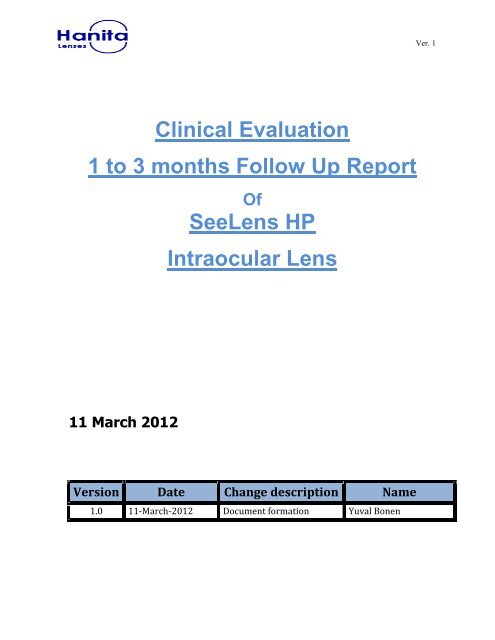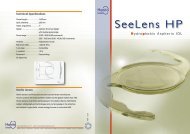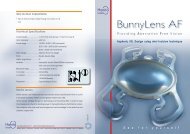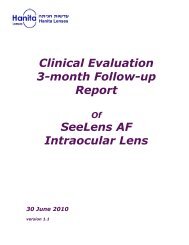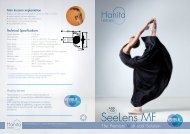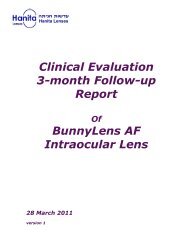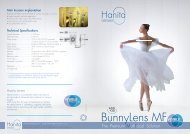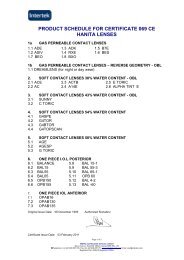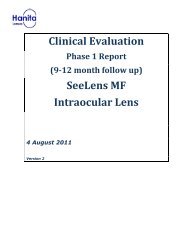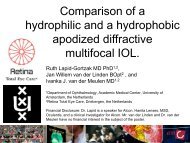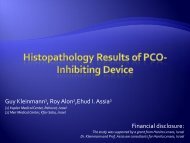Clinical Evaluation 1 to 3 months Follow Up Report SeeLens HP Intraocular Lens
SeeLens HP - Clinical Evaluation Report 11/03/2012 - Hanita Lenses
SeeLens HP - Clinical Evaluation Report 11/03/2012 - Hanita Lenses
- No tags were found...
You also want an ePaper? Increase the reach of your titles
YUMPU automatically turns print PDFs into web optimized ePapers that Google loves.
Ver. 1<strong>Clinical</strong> <strong>Evaluation</strong>1 <strong>to</strong> 3 <strong>months</strong> <strong>Follow</strong> <strong>Up</strong> <strong>Report</strong>Of<strong>See<strong>Lens</strong></strong> <strong>HP</strong><strong>Intraocular</strong> <strong>Lens</strong>11 March 2012VersionDateChange descriptionName1.011-March-2012Document formationYuval Bonen
Page 1 of 11Ver. 1Table of Contents1 OBJECTIVES ..................................................................................................................... 22 EFFICACY AND SAFETY ASSESSMENTS ................................................................. 23 MEDICAL DEVICE SPECIFICATION AND ADMINISTRATION .......................... 23.1 SPECIFICATIONS............................................................................................................ 23.1.1 Device description .................................................................................................... 23.1.2 <strong>See<strong>Lens</strong></strong> <strong>HP</strong> design ................................................................................................... 43.1.3 Surgical Procedure ................................................................................................... 64 METHODS .......................................................................................................................... 74.1 SAMPLE SIZE ................................................................................................................. 74.2 STATISTICAL METHODS ................................................................................................ 75 RESULTS ............................................................................................................................ 85.1 POST-OPERATIVE UNCORRECTED VISUAL ACUITY (UCVA)........................................ 85.2 POST-OPERATIVE BEST CORRECTED VISUAL ACUITY (BCVA).................................... 85.3 REFRACTION PREDICTABILITY ...................................................................................... 95.4 IOL PERFORMANCE .................................................................................................... 105.5 ADVERSE EVENTS AS DEFINED BY ISO 11979-7 2001 ................................................ 106 CONCLUSIONS ............................................................................................................... 117 APPROVALS .................................................................................................................... 11Hanita <strong>Lens</strong>es <strong>Intraocular</strong> & Contact <strong>Lens</strong>esעדשות חניתהעדשות מגע ועדשות השתלה תוך-עינית•קיבוץ חניתה • 88222 www.hanitalenses.com Kibbutz Hanita 22885 Israel • Tel. 972-4-9950 700• Fax: 972-4-9950 755 •
Page 2 of 11Ver. 11 ObjectivesThe objective of this study is <strong>to</strong> evaluate the safety and efficacy of the <strong>See<strong>Lens</strong></strong> <strong>HP</strong> IOL,implanted following cataract removal by phacoemulsification.a. The key efficacy parameters are:- Best Corrected Visual Acuity (BCVA)- Predictability of refraction.b. The key safety parameters include:- IOL performance during implantation and follow-up.- IOL related infection and/or inflamma<strong>to</strong>ry reactions.2 Efficacy and Safety AssessmentsThe efficacy and safety assessments were determined as defined by and according <strong>to</strong> the ISO11979 directive. The following are the demands required by the directive:1. Post Operative BCVA of at least 6/12 (20/40) within 88% of patients' population. For the"best cases" patients, BCVA 6/12 (20/40) or better, for at least 94% of the patients.(Requirements defined by ISO 11979-7 2001).2. IOL related Post Operative complication and Adverse Events equal <strong>to</strong> or less then theallowed rate defined by ISO 11979-7 2001.3. Refraction deviations criteria were established according <strong>to</strong> literature. The standard foraccuracy for normal eyes was addressed in study "Benchmark standards for refractiveoutcomes after NHS cataract surgery." The authors concluded that the "benchmark"standard for refractive outcomes for normal eyes after cataract surgery should be within±0.50 D for 55% of cases and within ±1.00 D for 85% of cases (Gale RP, Saldana M,Johns<strong>to</strong>n RL, Zuberbuhler B, McKibbin M. Benchmark standards for refractive outcomesafter NHS cataract surgery. Published on-line in Eye, 24 August 2007)3 Medical Device Specification and Administration3.1 Specifications3.1.1 Device description<strong>See<strong>Lens</strong></strong> <strong>HP</strong> is a single-piece hydrophobic acrylic, aspheric, posterior chamber intraocularlens. The <strong>See<strong>Lens</strong></strong> <strong>HP</strong> is CE marked since 2009 and being sold in many countriesworldwide. <strong>See<strong>Lens</strong></strong> <strong>HP</strong> is an important member in the <strong>See<strong>Lens</strong></strong> family which is knownfor its leading design, safety, stability and vision predictability.The <strong>See<strong>Lens</strong></strong> <strong>HP</strong> is made of hydrophobic acrylic material, which is known <strong>to</strong> be superiorin postponing the posterior capsular opacification (PCO).Hanita <strong>Lens</strong>es <strong>Intraocular</strong> & Contact <strong>Lens</strong>esעדשות חניתהעדשות מגע ועדשות השתלה תוך-עינית•קיבוץ חניתה • 88222 www.hanitalenses.com Kibbutz Hanita 22885 Israel • Tel. 972-4-9950 700• Fax: 972-4-9950 755 •
Page 3 of 11Ver. 1<strong>See<strong>Lens</strong></strong> <strong>HP</strong> SpecificationsGeometryMaterialPower rangeYAG laserOptic designPlacementYAG laserInjec<strong>to</strong>r size- Overall diameter: 13 mm- Optic Diameter: 6.0 mm- C loop haptic design- Haptic thickness: 0.3mm- Haptic angulation: 5º- Square Edge height: 0.07mm- Maximal lens thickness is 1.2mmBENZ HF1.2 Natural Yellow Universal BlankRefractive index: 1.485 (35º c)Compatible with YAG laser+10.5 <strong>to</strong> +30 (0.5D increments)+5 <strong>to</strong> +10 (1D increments)+31 <strong>to</strong> +35 (1D increments)CompatibleAsphericCapsular bagCompatible
Page 4 of 11Ver. 13.1.2 <strong>See<strong>Lens</strong></strong> <strong>HP</strong> designMotivation – visual acuityHanita <strong>Lens</strong>es search for vision quality improvements has a shared objective for bothrefractive and cataract surgery. The main goal for the refractive and cataract surgery is <strong>to</strong>provide the patient with the best visual acuity and good post operative refraction thatcurrent technology allows.The quest for an improved visual acuity for the cataract patient led Hanita <strong>Lens</strong>es <strong>to</strong>develop an aspheric-shaped lens. Designed <strong>to</strong> allow the patient a sharper image in theregular pho<strong>to</strong>pic vision (daylight vision), and reduce the aberrations of mesopic andsco<strong>to</strong>pic vision (twilight and night vision), which are noticed by some of the conventionalspherical Intra Ocular <strong>Lens</strong> implanted patients.Figure 2: The Black line defines the pho<strong>to</strong>pic vision and the green line defines the sco<strong>to</strong>pic vision.The area between the graphs defines the sco<strong>to</strong>pic vision.Hydrophobic material – preventing PCOThe <strong>See<strong>Lens</strong></strong> <strong>HP</strong> is made of hydrophobic acrylic material, which is known <strong>to</strong> be superiorin postponing the posterior capsular opacification (PCO), thus reducing the need for theYAG laser treatment. Moreover, hydrophobic materials are known <strong>to</strong> be more stablewithin the posterior capsule with respect <strong>to</strong> the hydrophilic lenses due <strong>to</strong> its higherstiffness with respect <strong>to</strong> the hydrophilic acrylic material. The <strong>See<strong>Lens</strong></strong> <strong>HP</strong> aspheric opticaldesign is identical <strong>to</strong> the <strong>See<strong>Lens</strong></strong> AF, Hanita <strong>Lens</strong>es’ premium product. The <strong>See<strong>Lens</strong></strong> <strong>HP</strong>is made of a different raw material, BENZ HF-1.2 Natural Yellow. This material haschemical composition very similar <strong>to</strong> the backbone structure of the BENZ IOL 25 NaturalYellow material.Spherical aberrationThe spherical aberration is a well known phenomenon in the optic field. The sphericalaberration occurs when rays of light that pass through different parts of the lens intersectat different points on the optical axis of the lens (Figure 3). Due <strong>to</strong> this aberration, a dotHanita <strong>Lens</strong>es <strong>Intraocular</strong> & Contact <strong>Lens</strong>esעדשות חניתהעדשות מגע ועדשות השתלה תוך-עינית•קיבוץ חניתה • 88222 www.hanitalenses.com Kibbutz Hanita 22885 Israel • Tel. 972-4-9950 700• Fax: 972-4-9950 755 •
Page 5 of 11Ver. 1projected on the retina produces a larger circle, thus inducing low quality optics, anunclear vision and low contrast (Figure 4).Figure 3:Spherical Aberration Figure 4:A demonstration of the blur caused by spherical aberration with a widerpupil. The rays that enter the retina from far scatter differently and areprojected blurredly <strong>to</strong> the retina, causing a law quality image.Contribu<strong>to</strong>rs <strong>to</strong> spherical aberration (SA) in the eye are the cornea (average +0.27 m) and thecrystalline lens (negative in the young eye). Cataract surgery removes the lens component andleaves positive SA on average. Traditional intraocular lenses (IOLs) are spherical withpositive SA, further increasing the SA of the pseudophakic eye.<strong>Clinical</strong> demandAs it gets darker and the pupil dilates, the spherical aberration becomes more apparent, andstarts <strong>to</strong> be noticeable by the patient. Thus patients with conventional spherical lensescomplain of unclear vision and poor contrast in the mesopic and sco<strong>to</strong>pic conditions.Influence of tilt and decentrationThe <strong>See<strong>Lens</strong></strong> <strong>HP</strong> is based upon the mechanical design of <strong>See<strong>Lens</strong></strong> AF IOL. The <strong>See<strong>Lens</strong></strong> AFdesign was proven <strong>to</strong> have good stability and good resistance <strong>to</strong> tilt and centration as well.Moreover, the <strong>See<strong>Lens</strong></strong> <strong>HP</strong> Optical design was demonstrated by the ZEEMAX <strong>to</strong> have goodresilience in terms of tilt and decentration as presented in the attached graph.Figure 7: The influence of the degree of Tilt on the resultant MTFHanita <strong>Lens</strong>es <strong>Intraocular</strong> & Contact <strong>Lens</strong>esעדשות חניתהעדשות מגע ועדשות השתלה תוך-עינית•קיבוץ חניתה • 88222 www.hanitalenses.com Kibbutz Hanita 22885 Israel • Tel. 972-4-9950 700• Fax: 972-4-9950 755 •
Page 6 of 11Ver. 1Figure 8: The influence of the degree of Tilt on the resultant MTF3.1.3 Surgical ProcedureThe study Surgery Procedure: cataract extraction by ECCE Phacoemolsification.Operation was performed according <strong>to</strong> the routine surgery technique of the investigativesites.The surgical procedure was conducted according <strong>to</strong> pro<strong>to</strong>col.Hanita <strong>Lens</strong>es <strong>Intraocular</strong> & Contact <strong>Lens</strong>esעדשות חניתהעדשות מגע ועדשות השתלה תוך-עינית•קיבוץ חניתה • 88222 www.hanitalenses.com Kibbutz Hanita 22885 Israel • Tel. 972-4-9950 700• Fax: 972-4-9950 755 •
Page 7 of 11Ver. 14 Methods4.1 Sample size23 eyes, who met the inclusion / exclusion criteria for the study pro<strong>to</strong>col. The study wascarried out starting from August 2011.The Investigative sites were:SiteDr. Yatziv YossiAsota Hashalom Medical CenterProf. Assia EhudEin-Tal Medical CenterNumber ofimplanted eyesNumber of eyes with 1-3<strong>months</strong> of follow up27 1311 104.2 Statistical MethodsThe following analyses were used <strong>to</strong> describe the data in this report:1. Descriptive statistics: continuous variables are described with mean ± standard deviation(SD). Nominal scale variables are described with absolute and relative (percents)frequencies. Ordinal variables are described with means ± SD and frequencies of theordinal grades.2. All analyses were done using Excel 2007 statistics <strong>to</strong>ol package.Hanita <strong>Lens</strong>es <strong>Intraocular</strong> & Contact <strong>Lens</strong>esעדשות חניתהעדשות מגע ועדשות השתלה תוך-עינית•קיבוץ חניתה • 88222 www.hanitalenses.com Kibbutz Hanita 22885 Israel • Tel. 972-4-9950 700• Fax: 972-4-9950 755 •
Page 8 of 11Ver. 15 Results5.1 Post-operative UnCorrected Visual Acuity (UCVA)UnCorrected Visual Acuity (UCVA) was reported in one <strong>to</strong> three <strong>months</strong> post operation.Post operative UCVA results are shown on Graph 1.Graph 1: Post-operative UCVA distributionAs shown in graph 1, 1-3 <strong>months</strong> pos<strong>to</strong>perative UCVA of 6/12 or better was reported in 65%of all eyes. Excluding eyes with ocular diseases (not IOL related) or high cylinder 87% of theeyes were reported of 6/12 or better.In summary, average UCVA of all eyes was 0.6(6/10)±0.29.5.2 Post-operative Best Corrected Visual Acuity (BCVA)Best Corrected Visual Acuity (BCVA) was reported in one <strong>to</strong> three <strong>months</strong> post operation.Post operative BCVA results are shown on Graph 2.Hanita <strong>Lens</strong>es <strong>Intraocular</strong> & Contact <strong>Lens</strong>esעדשות חניתהעדשות מגע ועדשות השתלה תוך-עינית•קיבוץ חניתה • 88222 www.hanitalenses.com Kibbutz Hanita 22885 Israel • Tel. 972-4-9950 700• Fax: 972-4-9950 755 •
Page 9 of 11Ver. 1Graph 2: Post-operative BCVA distributionAs shown in graph 2, 1-3 <strong>months</strong> pos<strong>to</strong>perative BCVA of 6/9 or better was reported in 81% ofall eyes. Excluding eyes with ocular diseases (not IOL related) 100% of the eyes werereported of 6/9 or better with average BCVA of 0.88(6/6.8) ±0.15.In summary, average BCVA of all eyes was 0.77(6/7.8) ±0.29.5.3 Refraction PredictabilityRefraction data of 21 eyes was reported in order <strong>to</strong> evaluate the predictability of pos<strong>to</strong>perative refraction using the <strong>See<strong>Lens</strong></strong> <strong>HP</strong> IOL. Subtracting the target refraction from thepos<strong>to</strong>perative refraction results the dSE (delta Spherical Equivalent) which is the mainparameter considering refraction predictability of an IOL.The dSE results are presented on Graph 3.Hanita <strong>Lens</strong>es <strong>Intraocular</strong> & Contact <strong>Lens</strong>esעדשות חניתהעדשות מגע ועדשות השתלה תוך-עינית•קיבוץ חניתה • 88222 www.hanitalenses.com Kibbutz Hanita 22885 Israel • Tel. 972-4-9950 700• Fax: 972-4-9950 755 •
Page 10 of 11Ver. 1Graph 3: Refraction predictability (dSE)As can be seen in graph 3, 100% of the eyes implanted by Dr. Yatziv were found with dSEless than 0.5D. 100% of the eyes implanted by Prof. Assia were found with dSE less than 1D.Table 1 summaries the dSE results:dSE valueDr. Yatziv 0.08±0.28Prof. Assia -0.24±0.68Total -0.08±0.535.4 IOL PerformanceAll implantations were reported successful as the lens handling, folding and implantationwere easy and smooth.Dr. Yatziv reported of a few IOLs with glistening found one week post op, which was foundstable in the later follow ups, with no effect on visual acuity. Prof. Assia had also reported oftwo IOLs with glistening two <strong>months</strong> post op, again with no effect on the visual acuity.5.5 Adverse Events as defined by ISO 11979-7 2001No adverse events were reported by the surgeons. Thus, it can be concluded that the <strong>See<strong>Lens</strong></strong><strong>HP</strong> safety is fully in accordance <strong>to</strong> the ISO 11979-7 2001Hanita <strong>Lens</strong>es <strong>Intraocular</strong> & Contact <strong>Lens</strong>esעדשות חניתהעדשות מגע ועדשות השתלה תוך-עינית•קיבוץ חניתה • 88222 www.hanitalenses.com Kibbutz Hanita 22885 Israel • Tel. 972-4-9950 700• Fax: 972-4-9950 755 •
Page 11 of 11Ver. 16 ConclusionsThe detailed data from the current study on 23 eyes shows the benefits of the <strong>See<strong>Lens</strong></strong> <strong>HP</strong>IOL:Optical performance is in accordance <strong>to</strong> ISO 11979-7 requirements.The safety of the lens is demonstrated, as no adverse events and complications werereported.7 ApprovalsHanita <strong>Lens</strong>es <strong>Intraocular</strong> & Contact <strong>Lens</strong>esעדשות חניתהעדשות מגע ועדשות השתלה תוך-עינית•קיבוץ חניתה • 88222 www.hanitalenses.com Kibbutz Hanita 22885 Israel • Tel. 972-4-9950 700• Fax: 972-4-9950 755 •


